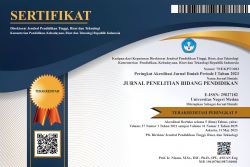THE EFFECT OF SCIENTIFIC INQUIRY LEARNING MODEL ASSISTED BY VIRTUAL LABORATORY TO STUDENT™S SCIENCE PROCESS SKILL ON DYNAMICS AND EQUILIBRIUM OF RIGID BODIES TOPIC
DOI:
https://doi.org/10.24114/jpbp.v24i1.12165Keywords:
Scientific inquiry learning model, student’s physics science process skillsAbstract
The purposes of this research are to know student™s science process skills using scientific inquiry learning model on dynamics and equilibrium of rigid bodies topic, to know student™s science process skills using conventional learning on dynamics and equilibrium of rigid bodies topic, to know the student™s activity based on science process skills indicator during the learning process using the scientific inquiry learning model, and to know the effect of scientific inquiry learning model on student™s science process skills on dynamics and equilibrium of rigid bodies topic. The type of this research is quasi experimental which using pre-test and post-test design. The population are all of students of class XI SMAN 1 Perbaungan, consist of 4 classes. Two classes of them are used for the sample. Experiment class using scientific inquiry learning model and control class using conventional learning. The result of research shows that the level of students™ science process skills in experiment class is a good criteria with the developed as the first meeting is 53.08, the second meeting is75.61, and the third meeting is 85.49. The average of pre-test in experiment class is 34.35 and in control class 34.53. The average of post-test in experiment class is 66 while in control class is 60. From one tail t-test can concluded there is influence of scientific inquiry learning model on students™ science process skills on dynamics and equilibrium of rigid bodies in class XI SMAN 1 Perbaungan.References
Anderson, Ronald D., (2002), Reforming Science Teaching: What Research say about Inquiry, Journal of Science Teacher Education, 13(2):(1-12),U.S.A Anggraini, D.P., & Sani, R.A., (2015), Analisi Model Pembelajaran Scientific Inquiry dan Kemampuan Berpikir Kreatif Terhadap Keterampilan Proses Sains Siswa, Jurnal Pendidikan Fisika, 4 (2):(48-54). Hamalik, O., (2011), Kurikulum dan pembelajaran, Jakarta: Bumi Aksara. Harlen, W., & Elsegeest, J., (1992), UNESCO Sourcebook for Science in The Primary School, UNESCO, France.
Joyce, B., Weil, M., and Cathoun, E. (2008). Models of Teachig, 8th ed. Englewood Cliffs, NJ: Prentice-Hall. Manlove, S., Lazonder, A.W., & De Jong, T., (2006), Regulative Support for Collaborative Scientific Inquiry Learning, Journal of Computer Assisted Learning, 22(2):(87-89) Netherlands. Muslim, K., & Tapilouw, F.S., (2015), Pengaruh Model Inquiri Ilmiah Terhadap Peningkatan Keterampilan Proses Sains Siswa SMP Pada Materi Kalor dalam Kehidupan, Center For Science Education. EDUSAINS, VII (1):(88-96). Rofi™ah, N.L., Suwono, H., & Listyorini, D., (2016), Pengaruh Scientific Inquiry Based Learning Terhadap Keterampilan Proses Sains Siswa Kelas XI SMA, Jurnal Pendidikan: Teori, Penelitian, dan Pengembangan, 1 (6):(1086-1089). Ulmiah, N., Andriani, N., & Fathurahman, A., (2014), Studi Keterampilan Sains Siswa SMA Kelas X Pada Pembelajaran Fisika Pokok Bahasan Suhu dan Kalor Melalui Model Pembelajarn Kooperatif Tipe Group Investigation di SMA Negeri 11 Palembang, Jurnal Inovasi dan Pembelajaran Fisika, ISSN: 2355-7109. Wijaya, I G., (2013), Pengaruh model pembelajaran inkuiri berbantuan virtual laboratory terhadap pemahaman konsep fisika siswa kelas VII SMP Negeri I Negara tahun ajaran 2012/2013, Skripsi, Universitas Pendidikan Ganesha, Bali Zamista, A.A., & Kaniawati, I., (2015), Pengembangan Tes Keterampilan Proses Sains Materi Fluida Statis Kelas X SMA/MA, Prosiding Seminar Nasional Fisika (E-Journal) SNF, IV, pISSN: 2339-0654.
Downloads
Published
Issue
Section
License
Copyright (c) 2019 JURNAL PENELITIAN BIDANG PENDIDIKAN

This work is licensed under a Creative Commons Attribution 4.0 International License.
Authors who publish with this journal agree to the following terms:
a. Authors retain copyright and grant the journal right of first publication with the work simultaneously licensed under a Creative Commons Attribution License (https://creativecommons.org/licenses/by/4.0) that allows others to share the work with an acknowledgement of the work's authorship and initial publication in this journal.
b. Authors are able to enter into separate, additional contractual arrangements for the non-exclusive distribution of the journal's published version of the work (e.g., post it to an institutional repository or publish it in a book), with an acknowledgement of its initial publication in this journal.
c. Authors are permitted and encouraged to post their work online (e.g., in institutional repositories or on their website) prior to and during the submission process, as it can lead to productive exchanges, as well as earlier and greater citation of published work (See The Effect of Open Access).

